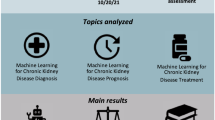Abstract
Background
C-terminal agrin fragment (CAF, size 22 kDa) is a promising new biomarker for kidney function. This study evaluated the usefulness of CAF as a serum biomarker for residual renal function (RRF) in patients undergoing automated peritoneal dialysis (APD).
Patients and methods
Serum, urine and dialysate samples were obtained in 12 end-stage renal disease patients undergoing APD. Total, renal and peritoneal clearances were calculated for CAF, creatinine, blood urea nitrogen (BUN) and cystatin c. kt/V was computed, and RRF (in ml/min) was calculated as the arithmetic mean of creatinine and BUN clearance. Correlations between the biomarkers’ serum concentrations, clearances, kt/V and RRF were computed.
Results
Serum CAF concentrations were highly correlated with serum concentrations of creatinine (r = 0.806, p = 0.002), BUN (r = 0.727, p = 0.007), cystatin c (r = 0.839, p = 0.001) and inversely to 24-h urinary output (r = −0.669, p = 0.017). RRF was inversely correlated with serum concentrations of CAF, cystatin c and creatinine being highest for CAF (r = −0.734, p = 0.007) followed by cystatin c (r = −0.65, p = 0.022) and creatinine (r = −0.606, p = 0.037). Serum BUN was not significantly associated with RRF (r = −0.497, p = 0.101). Age, weight and gender did not significantly affect serum CAF concentrations.
Conclusion
Serum CAF provides a robust serum biomarker for RRF in peritoneal dialysis patients undergoing APD, possibly outperforming the value of conventional biomarkers.

Similar content being viewed by others
References
Burkhalter F, Steiger J, Dickenmann M (2012) A road map for patients with in imminent end-stage renal disease. Swiss Med Wkly 142:w13713
Sinnakirouchenan R, Holley JL (2011) Peritoneal dialysis versus hemodialysis: risks, benefits, and access issues. Adv Chronic Kidney Dis 18:428–432
Lukowsky LR, Mehrotra R, Kheifets L, Arah OA, Nissenson AR, Kalantar-Zadeh K (2013) Comparing mortality of peritoneal and hemodialysis patients in the first 2 years of dialysis therapy: a marginal structural model analysis. Clin J Am Soc Nephrol 8:619–628
Vilar E, Farrington K (2011) Emerging importance of residual renal function in end-stage renal failure. Semin Dial 24:487–494
Marron B, Remon C, Perez-Fontan M, Quiros P, Ortiz A (2008) Benefits of preserving residual renal function in peritoneal dialysis. Kidney Int Suppl 108:S42–S51
Van Olden RW, Krediet RT, Strujik DG, Arisz L (1996) Measurement of residual renal function in patients treated with continuous ambulatory peritoneal dialysis. J Am Soc Nephrol 7:745–750
Carter JL, Lane CE, Fan SL, Lamb EJ (2011) Estimation of residual glomerular filtration rate in peritoneal dialysis patients using cystatin C: comparison with 51Cr-EDTA clearance. Nephrol Dial Transplant 26:3729–3732
Adachi Y, Nishio A (2010) A simple method to evaluate residual renal function by spot urinary cystatin C-to-creatinine ratio in peritoneal dialysis patients. Perit Dial Int 30:464–467
Steubl D, Hettwer S, Vrijbloed W, Dahinden P, Wolf P, Luppa P, Wagner CA, Renders L, Heemann U, Roos M (2013) C-terminal agrin fragment (CAF)—a new fast biomarker for kidney function in renal transplant recipients. Am J Nephrol 38:501–508
Steubl D, Hettwer S, Dahinden P, Wolf P, Luppa P, Wagner CA, Küchle C, Schmaderer C, Renders L, Heemann U, Roos M (2014) Influence of high-flux hemodialysis and hemodiafiltration on serum C-terminal agrin fragment levels in end-stage renal disease patients. Transl Res. pii: S1931-5244(14)00168-6. doi:10.1016/j.trsl.2014.05.005 [Epub ahead of print]
Watson PE, Watson ID, Batt RD (1980) Total body water volumes for adult males and females estimated from simple anthropometric measurements. Am J Clin Nutr 33:27–39
Kim SJ, Sohn YB, Park SW, Jin DK, Paik KH (2011) Serum cystatin C for estimation of residual renal function in children on peritoneal dialysis. Pediatr Nephrol 26:433–440
Montini G, Amici G, Milan S, Mussap M, Naturale M, Rätsch IM, Ammenti A, Sorino P, Verrina P, Andreetta B, Zacchello G (2002) Middle molecule and small protein removal in children on peritoneal dialysis. Kidney Int 61:1153–1159
Yang Q, Li R, Zhong Z, Mao H, Fan J, Lin J, Yang X, Wang X, Li Z, Yu X (2011) Is cystatin C a better marker than creatinine for evaluating residual renal function in patients on continuous ambulatory peritoneal dialysis? Nephrol Dial Transplant 26:3358–3365
Delaney MP, Stevens PE, Al Hasani M, Stowe HJ, Judge C, Lamb EJ (2008) Relationship of serum cystatin C to peritoneal and renal clearance measures in peritoneal dialysis: a cross-sectional study. Am J Kidney Dis 51:278–284
Mulay A, Biyani M, Akbari A (2008) Cystatin C and residual renal function in patients on peritoneal dialysis. Am J Kidney Dis 52:194–195
Knight EL, Verhave JC, Spiegelman D, Hillege HL, de Zeeuw D, Curhan GC, de Jong PE (2004) Factors influencing serum cystatin C levels other than renal function and the impact on renal function measurement. Kidney Int 65:1416–1421
Stevens LA, Schmid CH, Greene T, Li L, Beck GJ, Joffe MM, Froissart M, Kusek JW, Zhang YL, Coresh J, Levey AS (2009) Factors other than glomerular filtration rate affect serum cystatin C levels. Kidney Int 75:652–660
Acknowledgments
We thank Paul R. Albert, PhD, University of Ottawa, for revision of the manuscript.
Conflict of interest
Stefan Hettwer and Pius Dahinden are currently employed by Neurotune AG, Schlieren, Switzerland. The remaining authors of this manuscript have no conflicts of interest to disclose as described by the journal.
Author information
Authors and Affiliations
Corresponding author
Rights and permissions
About this article
Cite this article
Steubl, D., Hettwer, S., Dahinden, P. et al. C-terminal agrin fragment (CAF) as a serum biomarker for residual renal function in peritoneal dialysis patients. Int Urol Nephrol 47, 391–396 (2015). https://doi.org/10.1007/s11255-014-0852-5
Received:
Accepted:
Published:
Issue Date:
DOI: https://doi.org/10.1007/s11255-014-0852-5




